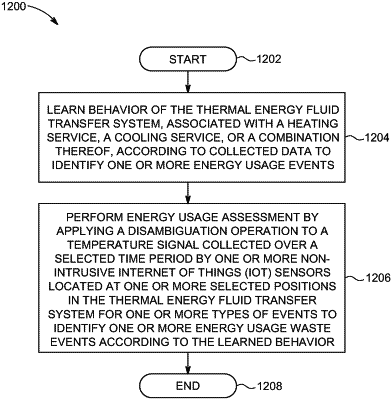| CPC G01K 7/01 (2013.01) [G01K 17/20 (2013.01); G06F 3/048 (2013.01); F22B 37/02 (2013.01); G01K 1/022 (2013.01); G01K 1/026 (2013.01); G01K 2213/00 (2013.01); G06N 20/00 (2019.01)] | 20 Claims |

|
1. A method for assessing energy in a thermal energy fluid transfer system in a cloud computing environment by a processor, comprising:
deploying a high frequency sampling operation in the thermal energy fluid transfer system associated with a heating service, a cooling service, or a combination thereof by identifying and accessing a data object within a data historian warehouse of existing resource infrastructure associated with the thermal energy fluid transfer system, and initiating the high frequency sampling operation using the data object, wherein the high frequency sampling operation samples data at a predetermined frequency for a predetermined time period, the predetermined time period comprising a time period during which a threshold amount of data is collected to use as training data as input to a machine learning operation modeling the thermal energy fluid transfer system, and wherein the data collected by the high frequency sampling operation is obtained by identifying a temperature of fluid transferred through the thermal energy fluid transfer system at the predetermined frequency;
executing machine learning logic performing the machine learning operation to use the training data to learn behavior of the thermal energy fluid transfer and generate tuning threshold levels for the modeling of the thermal energy fluid transfer system according to the learned behavior; and
performing energy usage assessment by applying a disambiguation operation to a single temperature signal, representing the temperature of the fluid and collected over a second predetermined time period by only a single non-intrusive Internet of Things (IoT) sensor coupled externally to a return piping section at a selected position in the thermal energy fluid transfer system, for one or more types of events to identify one or more energy usage waste events according to the learned behavior, wherein the disambiguation operation includes performing real-time statistical detection operations to identify a system-wide usage pattern of the thermal energy fluid transfer system using collected time-series data from only a single data point by the single non-intrusive IoT sensor, wherein the selected position includes coupling the single non-intrusive IoT sensor externally to the return piping at a selectively measured distance from a defined reference point of the thermal energy fluid transfer system, and wherein the single non-intrusive IoT sensor is externally coupled to the return piping comprising a loop of pipe network located subsequent to an energy load serviced by the thermal energy fluid transfer system to continuously sample temperature data to detect load and no load actions of the one or more energy usage waste events.
|